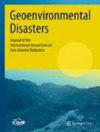Comparison of factors influencing landslide risk near a forest road in Chungju-si, South Korea
IF 4
Q2 ENVIRONMENTAL SCIENCES
引用次数: 0
Abstract
The study aimed to identify the influential factors required to prepare landslide vulnerability maps and establish disaster prevention measures for mountainous areas with forest roads. The target area is Sancheok-myeon, Chungju-si, where several landslides have occurred in a narrow area of approximately 3 km × 4 km. As the area has the same rainfall and vegetation conditions, the influences of the physico-mechanical characteristics of the soil in accordance with compaction and topographic characteristics could be analyzed precisely. Geological surveying, sampling, and laboratory testing assessed landslide risk in the study area, and data including unit weight, specific gravity, porosity, water content, soil depth, friction angle, cohesion, slope angle, profile/plan curvature, TWI were obtained. Preprocessing and screening such as min-max normalization and multicollinearity were conducted for the data in order to eliminate overestimation of each factor’s effectiveness. The influence of each factor was analyzed using logistic regression (LR), structural equation modeling (SEM), extreme gradient boosting (XGBoost), and light gradient boosting machine (LightGBM). All methods showed that soil depth has the greatest impact on landslide occurrence. Friction angle, slope angle, and porosity were also selected as influential factors, although each method ranked them slightly differently. Topographic factors, such as plan curvature, profile curvature, and the topographic wetness index, had minimal influence. This appears to be because landslides near forest roads are more affected by how well compaction was performed during banking than by the concave or convex shape of the slope. This study presents analysis results for an area with the same rainfall and vegetation conditions; therefore, the analysis of the influence of the physico-mechanical characteristics of the soil and topography was more precise than when comparing landslides occurring in different regions. Our results may be helpful in preparing landslide vulnerability maps.韩国忠州市林道路附近山体滑坡风险影响因素比较
该研究旨在确定编制山体滑坡脆弱性地图所需的影响因素,并为有林区道路的山区制定防灾措施。目标区域是忠州市的三岔面,在约 3 km×4 km 的狭长区域内发生过多次滑坡。由于该地区具有相同的降雨量和植被条件,因此可以根据压实和地形特征精确分析土壤物理机械特征的影响。通过地质勘测、取样和实验室测试评估了研究区域的滑坡风险,并获得了包括单位重量、比重、孔隙度、含水量、土层深度、摩擦角、内聚力、坡角、剖面/平面曲率、TWI 等数据。对数据进行了最小-最大归一化和多重共线性等预处理和筛选,以消除对各因素有效性的高估。利用逻辑回归(LR)、结构方程模型(SEM)、极梯度提升(XGBoost)和轻梯度提升机(LightGBM)分析了各因子的影响。所有方法都表明,土壤深度对滑坡发生的影响最大。摩擦角、坡角和孔隙度也被选为影响因素,但每种方法对它们的排序略有不同。地形因素,如平面曲率、剖面曲率和地形湿润指数,影响最小。这似乎是因为林区道路附近的滑坡更多受到筑坝时压实效果的影响,而不是受到斜坡凹凸形状的影响。本研究提供了对降雨量和植被条件相同的地区的分析结果;因此,与比较发生在不同地区的滑坡时相比,对土壤和地形的物理力学特征的影响分析更为精确。我们的研究结果可能有助于绘制滑坡易损性地图。
本文章由计算机程序翻译,如有差异,请以英文原文为准。
求助全文
约1分钟内获得全文
求助全文
来源期刊

Geoenvironmental Disasters
Social Sciences-Geography, Planning and Development
CiteScore
8.90
自引率
6.20%
发文量
22
期刊介绍:
Geoenvironmental Disasters is an international journal with a focus on multi-disciplinary applied and fundamental research and the effects and impacts on infrastructure, society and the environment of geoenvironmental disasters triggered by various types of geo-hazards (e.g. earthquakes, volcanic activity, landslides, tsunamis, intensive erosion and hydro-meteorological events).
The integrated study of Geoenvironmental Disasters is an emerging and composite field of research interfacing with areas traditionally within civil engineering, earth sciences, atmospheric sciences and the life sciences. It centers on the interactions within and between the Earth''s ground, air and water environments, all of which are affected by climate, geological, morphological and anthropological processes; and biological and ecological cycles. Disasters are dynamic forces which can change the Earth pervasively, rapidly, or abruptly, and which can generate lasting effects on the natural and built environments.
The journal publishes research papers, case studies and quick reports of recent geoenvironmental disasters, review papers and technical reports of various geoenvironmental disaster-related case studies. The focus on case studies and quick reports of recent geoenvironmental disasters helps to advance the practical understanding of geoenvironmental disasters and to inform future research priorities; they are a major component of the journal. The journal aims for the rapid publication of research papers at a high scientific level. The journal welcomes proposals for special issues reflecting the trends in geoenvironmental disaster reduction and monothematic issues. Researchers and practitioners are encouraged to submit original, unpublished contributions.
 求助内容:
求助内容: 应助结果提醒方式:
应助结果提醒方式:


